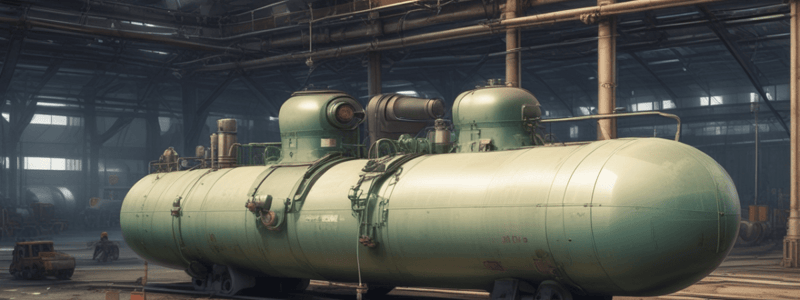Podcast
Questions and Answers
What is the purpose of the reinforcement straps inside the low pressure air bag?
What is the purpose of the reinforcement straps inside the low pressure air bag?
- To reduce the operating pressure of the bag
- To increase the capacity of the bag
- To prevent the bag from bulging and lateral movement (correct)
- To provide a larger footprint for the area being lifted
What is a common application of low pressure air bags?
What is a common application of low pressure air bags?
- Providing ventilation in confined spaces
- Cutting through metal debris
- Lifting or stabilizing overturned vehicles with thin metal walls (correct)
- Lifting heavy machinery
What is the advantage of low pressure air bags in terms of footprint?
What is the advantage of low pressure air bags in terms of footprint?
- They can be used on smooth surfaces only
- They provide a small footprint to minimize space
- They can be used on uneven surfaces
- They provide a large footprint for the area being lifted (correct)
What is the operating pressure for low pressure air bags?
What is the operating pressure for low pressure air bags?
What is required to maintain the rated capacity of a low pressure air bag?
What is required to maintain the rated capacity of a low pressure air bag?
What is the benefit of using low pressure air bags in trench rescue operations?
What is the benefit of using low pressure air bags in trench rescue operations?
When do low pressure air bags reach their maximum stability?
When do low pressure air bags reach their maximum stability?
What components are required to operate low pressure air bags?
What components are required to operate low pressure air bags?
What is the primary characteristic of a compressible fluid?
What is the primary characteristic of a compressible fluid?
What is the SI unit of pressure?
What is the SI unit of pressure?
What is the primary principle of Pascal's Law?
What is the primary principle of Pascal's Law?
What is the U.S. customary system unit of pressure?
What is the U.S. customary system unit of pressure?
What is the primary characteristic of an incompressible fluid?
What is the primary characteristic of an incompressible fluid?
What is the relationship between pressure and force?
What is the relationship between pressure and force?
What is the effect of an increase in pressure on the volume of a compressible fluid?
What is the effect of an increase in pressure on the volume of a compressible fluid?
What is the effect of an increase in pressure on the volume of an incompressible fluid?
What is the effect of an increase in pressure on the volume of an incompressible fluid?
What is the main difference in the construction of low pressure bags compared to medium pressure bags?
What is the main difference in the construction of low pressure bags compared to medium pressure bags?
What is the purpose of the multi-layer rubber on the top and bottom surfaces of low pressure bags?
What is the purpose of the multi-layer rubber on the top and bottom surfaces of low pressure bags?
What is not mentioned as a characteristic of low pressure bags?
What is not mentioned as a characteristic of low pressure bags?
How do low pressure bags differ from medium pressure bags in terms of air consumption?
How do low pressure bags differ from medium pressure bags in terms of air consumption?
What can be inferred about the operating pressure of low pressure bags?
What can be inferred about the operating pressure of low pressure bags?
What is the main application of low pressure bags?
What is the main application of low pressure bags?
How do low pressure bags compare to medium pressure bags in terms of materials used?
How do low pressure bags compare to medium pressure bags in terms of materials used?
What can be said about the design of low pressure bags?
What can be said about the design of low pressure bags?
What should you do to prepare for a lifting operation?
What should you do to prepare for a lifting operation?
Why is it important to support the load with cribbing material?
Why is it important to support the load with cribbing material?
What is the purpose of cribbing up to the load prior to inserting the airbag?
What is the purpose of cribbing up to the load prior to inserting the airbag?
What should you do when operating around air bags and lifting loads?
What should you do when operating around air bags and lifting loads?
Why is it important to work on a flat surface when possible?
Why is it important to work on a flat surface when possible?
What is the purpose of maintaining equipment not being utilized in a centralized area?
What is the purpose of maintaining equipment not being utilized in a centralized area?
What is the importance of 'lifting an inch, cribbing an inch'?
What is the importance of 'lifting an inch, cribbing an inch'?
What is the purpose of supporting the air bags with cribbing material?
What is the purpose of supporting the air bags with cribbing material?
Where should the uninflated bags be placed in relation to the load?
Where should the uninflated bags be placed in relation to the load?
What should be the gap between the bag and the load when slid under?
What should be the gap between the bag and the load when slid under?
What is the recommended approach for lifting the load?
What is the recommended approach for lifting the load?
How should the nipples on the bags be arranged for easier manageability?
How should the nipples on the bags be arranged for easier manageability?
What is the advantage of placing the in-line relief valve at the controller?
What is the advantage of placing the in-line relief valve at the controller?
Who is responsible for directing the rescuer at the controller?
Who is responsible for directing the rescuer at the controller?
What should the commands from the directing person to the rescuer be?
What should the commands from the directing person to the rescuer be?
Why should the bottom layer of the box crib be solid when working on soft ground?
Why should the bottom layer of the box crib be solid when working on soft ground?
Why do air hoses tend to develop a 'memory' in their rolled shape?
Why do air hoses tend to develop a 'memory' in their rolled shape?
What is the minimum recommended crib layout for a box crib?
What is the minimum recommended crib layout for a box crib?
What happens when a standard 2-by-2 layout is used for a box crib?
What happens when a standard 2-by-2 layout is used for a box crib?
How many high-pressure air bags can be stacked?
How many high-pressure air bags can be stacked?
What is the recommended arrangement when stacking high-pressure air bags?
What is the recommended arrangement when stacking high-pressure air bags?
What determines the total lifting capacity when stacking high-pressure air bags?
What determines the total lifting capacity when stacking high-pressure air bags?
What is the recommended approach when the load is at an angle?
What is the recommended approach when the load is at an angle?
What is the requirement for two air bags working in tandem?
What is the requirement for two air bags working in tandem?
When lifting a load with a patient pinned underneath, what should be done to prevent sway and further harm?
When lifting a load with a patient pinned underneath, what should be done to prevent sway and further harm?
What is the purpose of 'feathering' when lifting a load with air bags?
What is the purpose of 'feathering' when lifting a load with air bags?
Why should air bags be inflated slowly when lifting a load?
Why should air bags be inflated slowly when lifting a load?
When using multiple air bags to lift a load, what should be done to maintain control?
When using multiple air bags to lift a load, what should be done to maintain control?
What is the consequence of inflating an air bag rapidly when lifting a load?
What is the consequence of inflating an air bag rapidly when lifting a load?
What is the purpose of lifting one bag one inch and then the next bag one inch when using multiple air bags?
What is the purpose of lifting one bag one inch and then the next bag one inch when using multiple air bags?
When lifting a load with multiple air bags, what should be done to ensure the load is lifted safely?
When lifting a load with multiple air bags, what should be done to ensure the load is lifted safely?
Why is it important to crib the opposite side when lifting a load with a patient pinned underneath?
Why is it important to crib the opposite side when lifting a load with a patient pinned underneath?
What is the purpose of cleaning the retainer assembly of the Airgun and Pakhammer?
What is the purpose of cleaning the retainer assembly of the Airgun and Pakhammer?
What is the recommended practice for maintaining the oil level in the in-line oiler?
What is the recommended practice for maintaining the oil level in the in-line oiler?
What is the primary consideration for operators of air lifting bags?
What is the primary consideration for operators of air lifting bags?
What is the capacity of some of the largest air lifting bags?
What is the capacity of some of the largest air lifting bags?
What is one application of air lifting bags?
What is one application of air lifting bags?
What is essential for a successful lifting bag operation?
What is essential for a successful lifting bag operation?
What is a consideration when operating air lifting bags?
What is a consideration when operating air lifting bags?
Why is regular maintenance crucial for the Airgun and Pakhammer?
Why is regular maintenance crucial for the Airgun and Pakhammer?
What is the primary reason for maintaining a stance that allows for rapid egress from the danger area when operating around air bags and lifting loads?
What is the primary reason for maintaining a stance that allows for rapid egress from the danger area when operating around air bags and lifting loads?
What is the purpose of cribbing the load as it is being lifted?
What is the purpose of cribbing the load as it is being lifted?
Why is it important to keep the air bags close to the load as possible?
Why is it important to keep the air bags close to the load as possible?
What is the consequence of not supporting the load with cribbing material during lifting?
What is the consequence of not supporting the load with cribbing material during lifting?
Why is it recommended to work on a flat surface when possible during lifting operations?
Why is it recommended to work on a flat surface when possible during lifting operations?
What is the purpose of maintaining equipment not being utilized in a centralized area during lifting operations?
What is the purpose of maintaining equipment not being utilized in a centralized area during lifting operations?
What is the importance of 'lifting an inch, cribbing an inch' during lifting operations?
What is the importance of 'lifting an inch, cribbing an inch' during lifting operations?
What is the purpose of supporting the air bags with cribbing material during lifting operations?
What is the purpose of supporting the air bags with cribbing material during lifting operations?
Flashcards are hidden until you start studying
Study Notes
Low Pressure Air Bags
- Reinforced straps run from top to bottom plate to prevent bulging and lateral movement
- Comparable in size and capacity to medium pressure systems
- Used for lifting or stabilizing overturned vehicles, especially with thin metal walls
- Provide a large footprint to minimize punch-through
- Can be used to fill voids in trench rescue operations
- Reach maximum stability at full inflation
- Operate at 0.5 bar or 7-8 psi
- Require same components as medium pressure bags: air source, pressure regulator, controller, relief valves, and hoses
Fluids and Pressure
- Fluids can be categorized as compressible (gases) or incompressible (liquids)
- Compressible fluids: density significantly changes with pressure, volume decreases as pressure increases
- Incompressible fluids: density does not significantly change with pressure, volume remains constant
Pressure and Pascal's Law
- Pressure: force per unit area applied perpendicular to a surface
- Measured in pascals (Pa) or pounds per square inch (psi)
- Affected by changes in force or area
- Pascal's Law: a change in pressure in a confined fluid results in an equal change in pressure throughout the fluid and container
Medium Pressure Air Bags
- Used for lifting or stabilizing overturned vehicles with thin metal walls
- Provide a large footprint to minimize punch-through
- Used to fill voids in trench rescue operations
- Operate at 1 bar/14.5 psi
- Reach maximum stability at full inflation
- Require air source, air pressure regulator, controller with relief valves, and hoses
Preparing for Lifting Operations
- Identify potential danger areas and keep personnel and equipment clear of those areas
- Maintain a safe stance allowing for rapid egress in case of load shift or fall
- Keep unused equipment in a centralized, safe zone to minimize trip hazards
- Work on a flat surface to avoid slippage and shifting of air bags and loads
Cribbing
- Cribbing material is required to support the load when lifted from the ground
- Cribbing is used to support the load and the air bags
- The "lift an inch, crib an inch" rule is critical to prevent the load from traveling unsupported
- Cribbing helps maintain surface contact between the air bag and the ground, ensuring stability and strength
Supporting the Load
- Air bags must be as close to the load as possible to maximize lifting height
- Place uninflated bags just barely touching the load with no large space in between
- Locate a solid surface under the load and use it as the lifting point, cribbing on both sides of the bags
- The "lift an inch, crib an inch" rule applies here as well
Air Bag Placement and Control
- Place air bags as close to the load as possible to maximize lifting height
- Nipples on the bags can be stacked or staggered for easier hose management
- In-line relief valves can be placed at the controller or the bag
- The controller should be positioned in a safe zone with a full view of the lift
Lift Operations
- One person operates the controller, while another directs the rescuer at the controller
- Communications should be limited to "Up", "Down", and "Stop" commands with the color of the air hose
- Air hoses tend to develop a "memory" and should be stored properly to maintain full surface contact with the air bag
Box Crib Construction
- A minimum of 3-by-3 crib layout should be used to maintain full surface contact with the air bag
- A solid layer of cribbing is necessary on top and bottom when working on soft ground
Stacking Air Bags
- High-pressure air bags can be stacked up to two bags to increase lifting height
- The larger bag should be placed on the bottom, and the smaller bag on top
- The total lift height is the sum of the individual bag heights
- The smaller bag's capacity dictates the total lifting capacity when stacked
Air Bag Lifting Principles
- Air bags can be used in tandem to lift a load that exceeds the capacity of a single bag.
- Each bag must only see its rated capacity, and not be overloaded.
Tandem Lifting
- Two bags of the same capacity can be used in tandem to lift a load, with each bag lifting half of the load.
- The maximum tandem lifting capacity is achieved only at 1 inch of lift.
Lifting Considerations
- When lifting a load, especially if it is resting on a patient, every action has an equal and opposite reaction.
- Cribbing is necessary to provide a hinge point for the load and prevent sway, which could cause further harm to the individual.
- Bags should be inflated slowly to maintain control and prevent the load from shifting.
- If more than one bag is used, inflate one bag at a time to maintain control.
Cribbing
- Cribbing material is necessary to support the load and air bags when lifting.
- The "Lift an inch, crib an inch" rule is critical to prevent the load from traveling unsupported.
- Supporting the air bags with cribbing is necessary to prevent loss of surface contact with the ground.
Air Bag Maintenance
- Routine maintenance of air bags is necessary to keep them operating at peak efficiency.
- Keep the surface of the tools clean and free of dirt, grease, etc.
- Clean the retainer assembly with dry cleaning solvent and lubricate with air tool oil after use.
Air Bag Safety Precautions
- Always pay attention to the load and maintain a stance that allows for rapid egress from the danger area.
- Identify the area that might be affected if the load was to fall or shift and keep personnel and equipment clear.
- Maintain all equipment not being utilized in a centralized area, in the safe zone.
- Work on a flat surface to avoid slippage and shifting of the air bags and or the load.
Studying That Suits You
Use AI to generate personalized quizzes and flashcards to suit your learning preferences.




